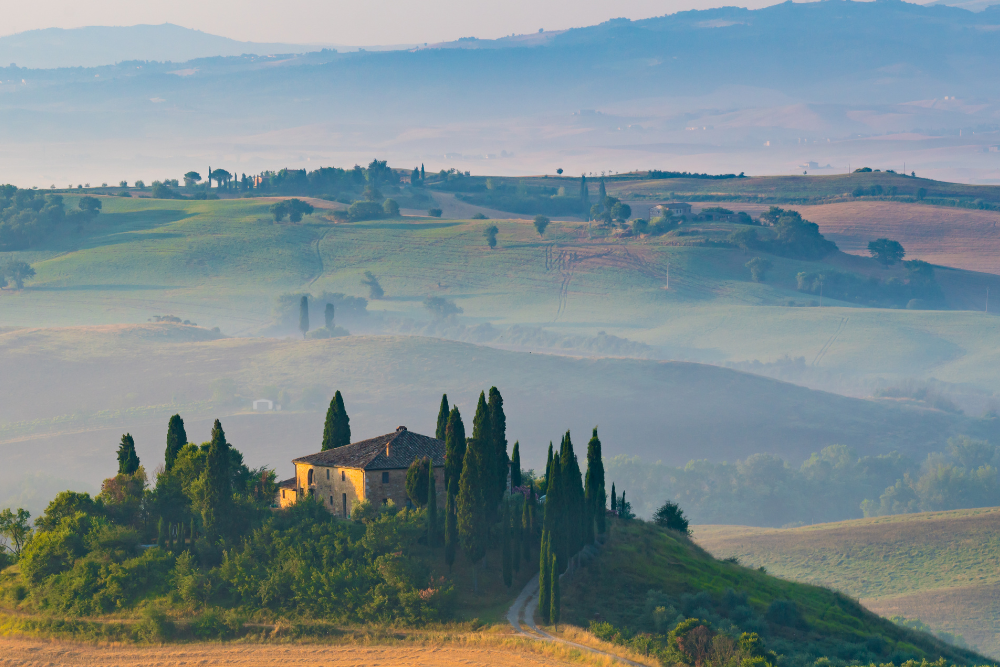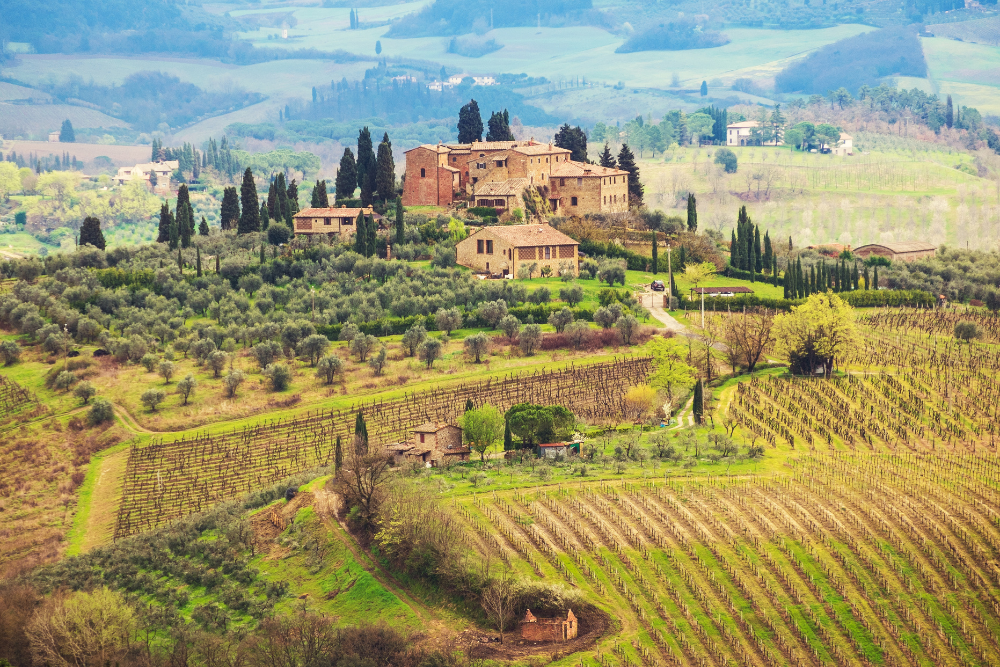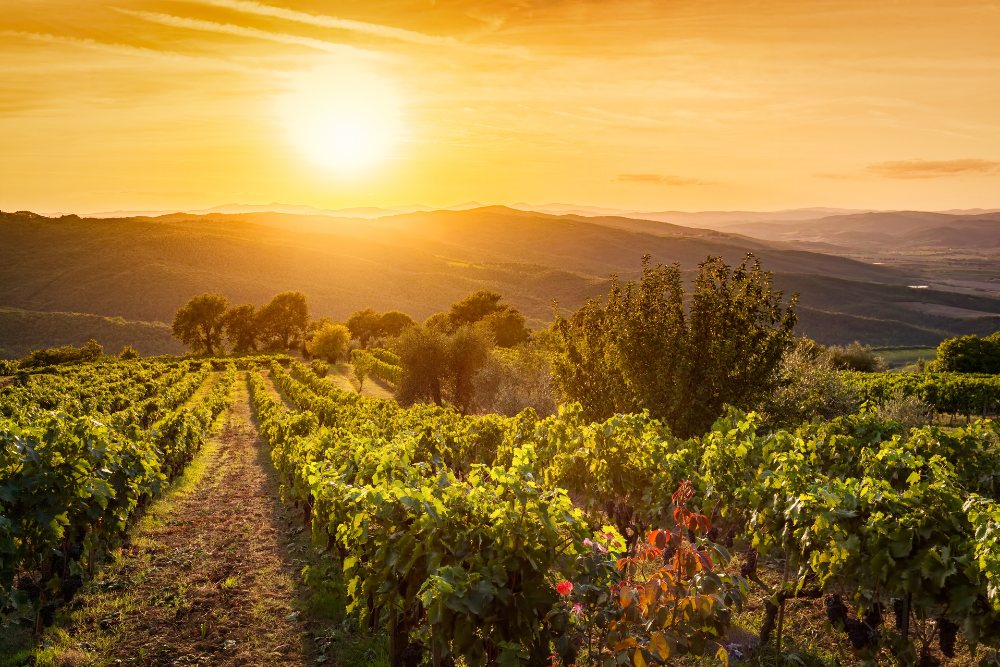The rolling hills, golden vineyards, olive groves, and charming villages of Tuscany have long inspired travelers from around the world. This picturesque region of Italy is a feast for the senses, offering stunning landscapes, delicious food, world-class wines, and a rich cultural heritage. If you’re planning a journey through Tuscany’s countryside, here’s a guide to help you experience the best it has to offer.
1. Discovering the Iconic Tuscan Landscapes

No trip to Tuscany is complete without immersing yourself in its breathtaking scenery.
- Val d’Orcia: A UNESCO World Heritage Site, this valley is quintessential Tuscany, with its rolling green hills, cypress-lined roads, and medieval hilltop towns like Pienza and Montepulciano. Stop by the famous Cappella della Madonna di Vitaleta, a picturesque chapel surrounded by cypress trees.
- Chianti Wine Region: Known for its vineyards and wineries, Chianti offers a quintessential Tuscan experience. Drive along the Via Chiantigiana, a scenic road that winds through olive groves and vineyards.
- Crete Senesi: This unique area near Siena features striking, clay-covered hills and lunar-like landscapes, particularly beautiful at sunrise or sunset.
Insider Tip: Rent a car or bike for flexibility and the chance to explore remote areas at your own pace.
2. Exploring Tuscany’s Hilltop Towns

The medieval and Renaissance towns of Tuscany are not to be missed. Each has its own charm and history.
- San Gimignano: Known as the “Town of Fine Towers,” San Gimignano is famous for its medieval skyline. Wander its cobblestone streets, climb the Torre Grossa, and enjoy gelato from Gelateria Dondoli, a world-renowned gelateria.
- Volterra: A quieter, less touristy gem, Volterra boasts ancient Etruscan ruins, a Roman theater, and the stunning Palazzo dei Priori, Tuscany’s oldest town hall.
- Cortona: Made famous by the book Under the Tuscan Sun, Cortona offers spectacular views, art galleries, and a relaxed vibe.
Insider Tip: Visit these towns early in the morning or late afternoon to avoid crowds and capture the best light for photos.
3. Tuscany’s Food and Wine Delights

Tuscany is a paradise for food and wine lovers, with its simple yet flavorful cuisine and celebrated wines.
- Local Delicacies:
- Try pappardelle al cinghiale, a pasta dish with wild boar sauce.
- Don’t miss ribollita, a hearty vegetable and bread soup.
- Indulge in bistecca alla Fiorentina, a thick, grilled T-bone steak.
- Wine Tasting:
- Visit the wineries of Montalcino to sample the prestigious Brunello di Montalcino.
- Explore Montepulciano, home to the rich Vino Nobile di Montepulciano.
- Stop by Bolgheri for Super Tuscans, premium red wines that have gained international acclaim.
Insider Tip: Join a wine tour or visit family-owned wineries for a more personalized experience. Many offer tastings paired with local cheeses and cured meats.
4. Cultural and Historical Highlights

Tuscany is a region steeped in history and culture, with plenty of landmarks and museums to explore.
- Abbazia di Sant’Antimo: Near Montalcino, this Romanesque abbey is a serene spot surrounded by vineyards and olive groves. Attend a Gregorian chant performance for a spiritual experience.
- Medici Villas and Gardens: Scattered across Tuscany, these UNESCO-listed sites showcase the legacy of the powerful Medici family. Villa La Petraia and Villa di Castello near Florence are particularly beautiful.
- Etruscan Heritage: Visit the Etruscan tombs in Tarquinia and the Guarnacci Etruscan Museum in Volterra to learn about Tuscany’s ancient history.
Insider Tip: Combine your visits to cultural sites with nearby restaurants or wineries to make the most of your day.
5. Relaxing in the Tuscan Countryside

For those seeking tranquility, Tuscany offers a variety of ways to relax and recharge.
- Thermal Baths:
- Soak in the natural hot springs of Bagno Vignoni, a charming village with a thermal pool in its main square.
- Visit the scenic outdoor baths at Saturnia, known for their cascading waterfalls and warm, sulfur-rich waters.
- Farm Stays (Agriturismi):
- Stay in a countryside farmhouse to experience rural Tuscan life. Many agriturismi offer cooking classes, wine tastings, and truffle-hunting excursions.
Insider Tip: Book well in advance during the high season (spring and fall), as these unique accommodations fill up quickly.
Practical Tips for Your Tuscan Journey
- Best Time to Visit:
- Spring (April-May) and fall (September-October) are ideal for mild weather, vibrant landscapes, and fewer crowds.
- Transportation:
- While Tuscany’s cities are well-connected by train, renting a car is the best way to explore the countryside and remote villages.
- What to Pack:
- Comfortable walking shoes, a reusable water bottle, and a camera to capture the stunning scenery.
- Respect Local Customs:
- Greet locals with “Buongiorno” (good morning) or “Buonasera” (good evening).
- Follow local dining hours, as many restaurants close between lunch and dinner.
Conclusion
A journey through Tuscany’s countryside is a dream come true for travelers seeking stunning landscapes, rich history, and unparalleled culinary experiences. From exploring medieval towns to savoring world-class wines and relaxing in natural hot springs, Tuscany offers something for everyone. Whether it’s your first visit or a return trip, this enchanting region will leave you with unforgettable memories and a yearning to come back for more.












